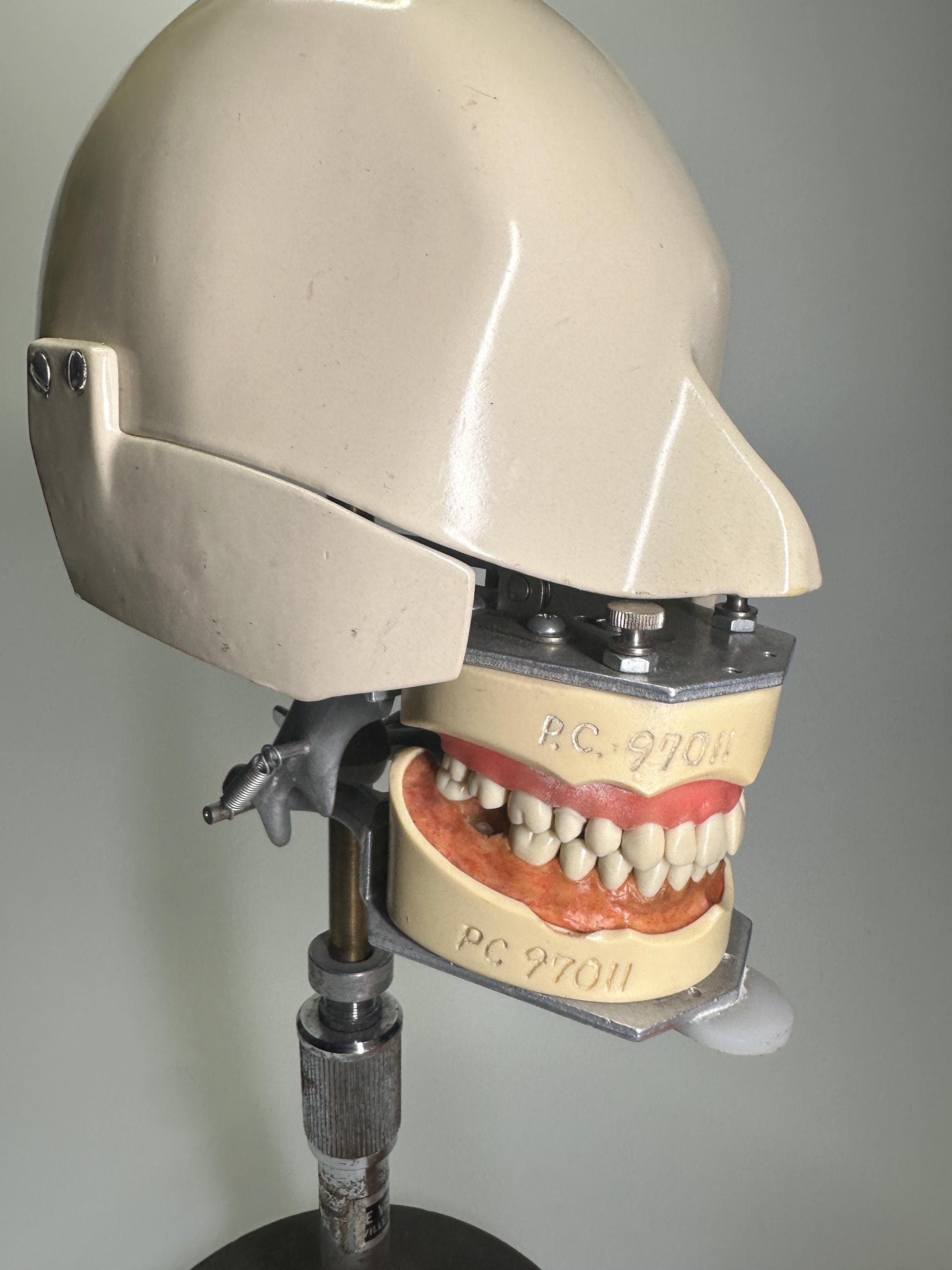 Image 1 of 10
Image 1 of 10

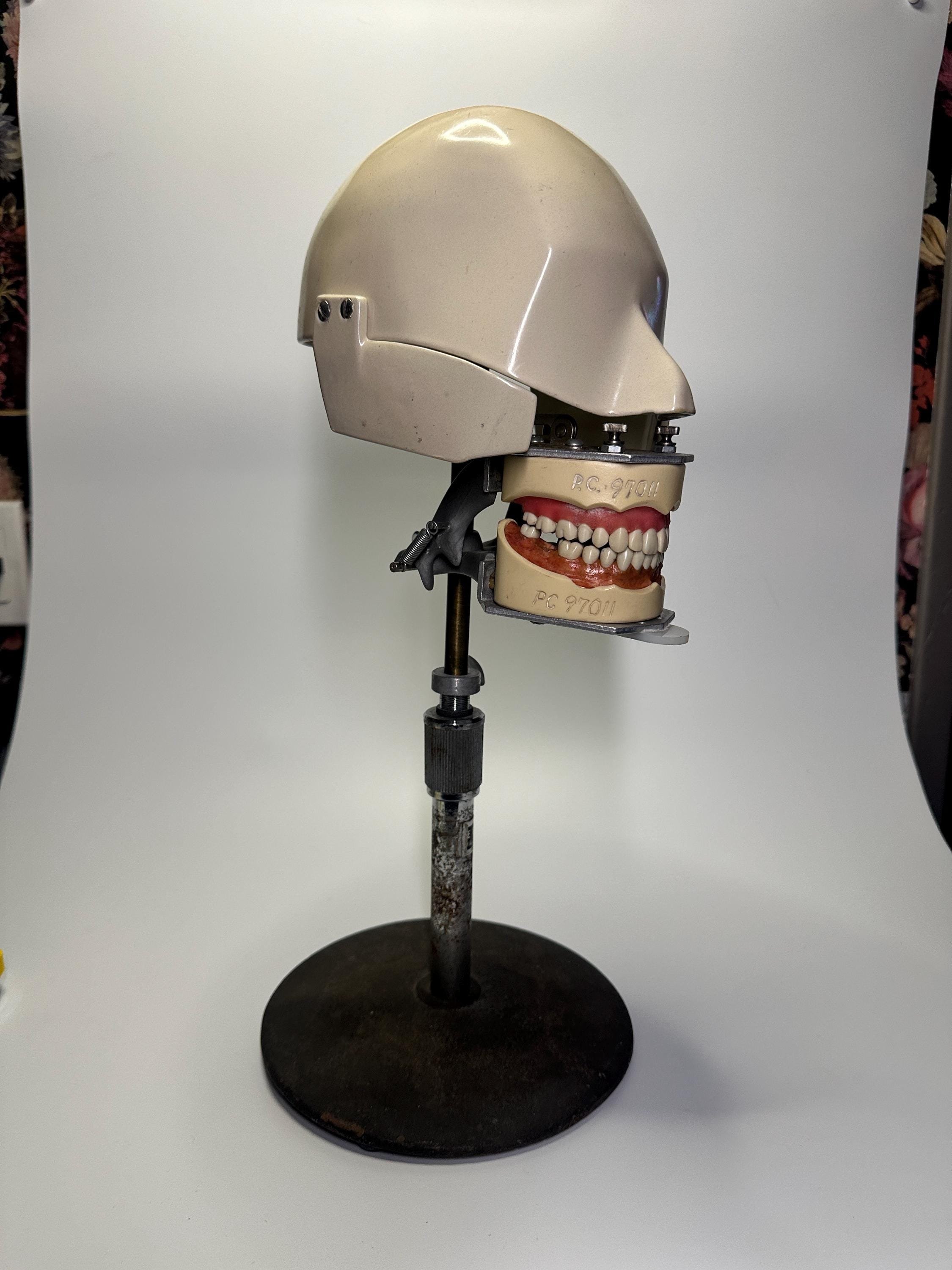 Image 2 of 10
Image 2 of 10

 Image 3 of 10
Image 3 of 10

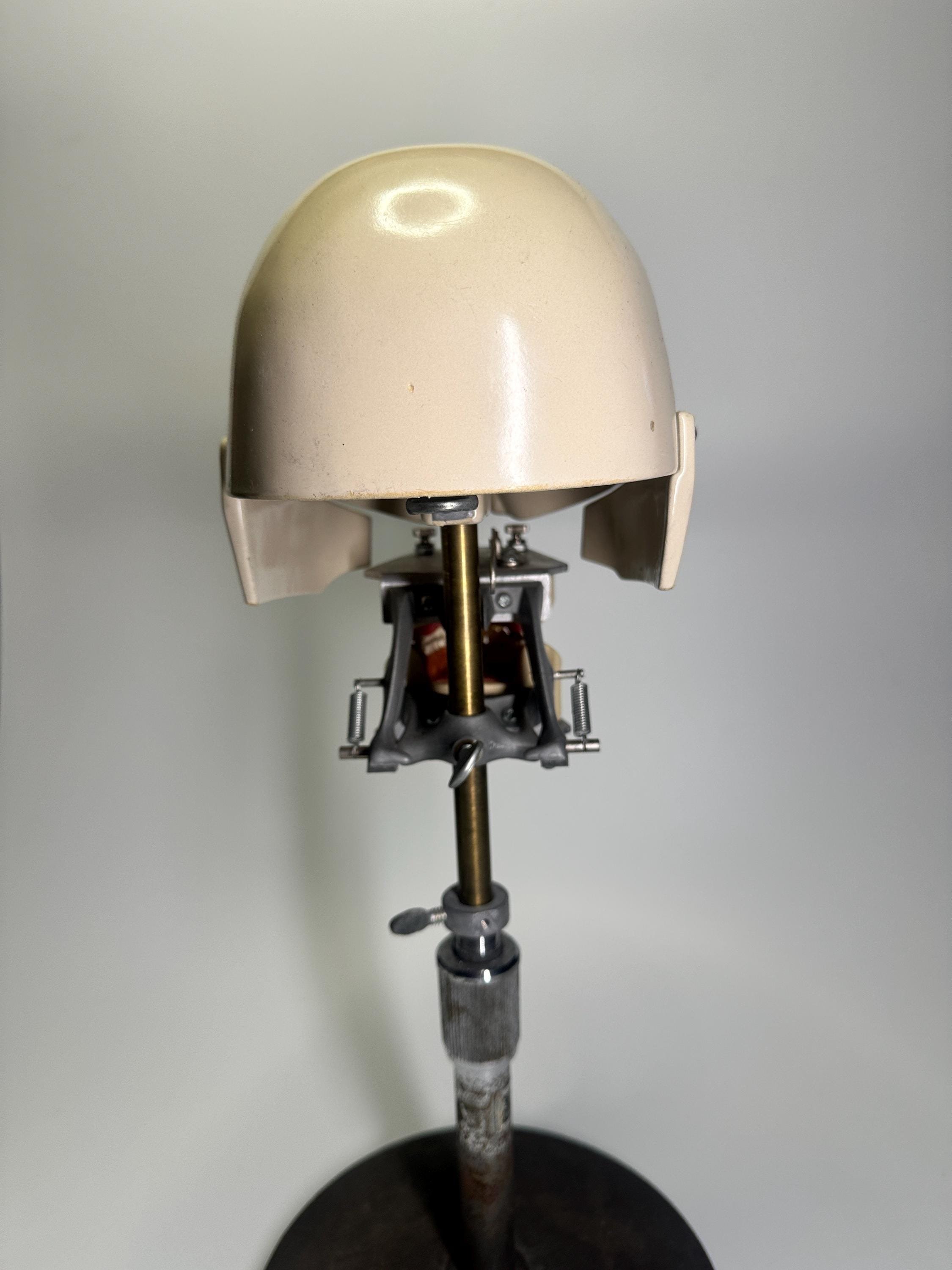 Image 4 of 10
Image 4 of 10

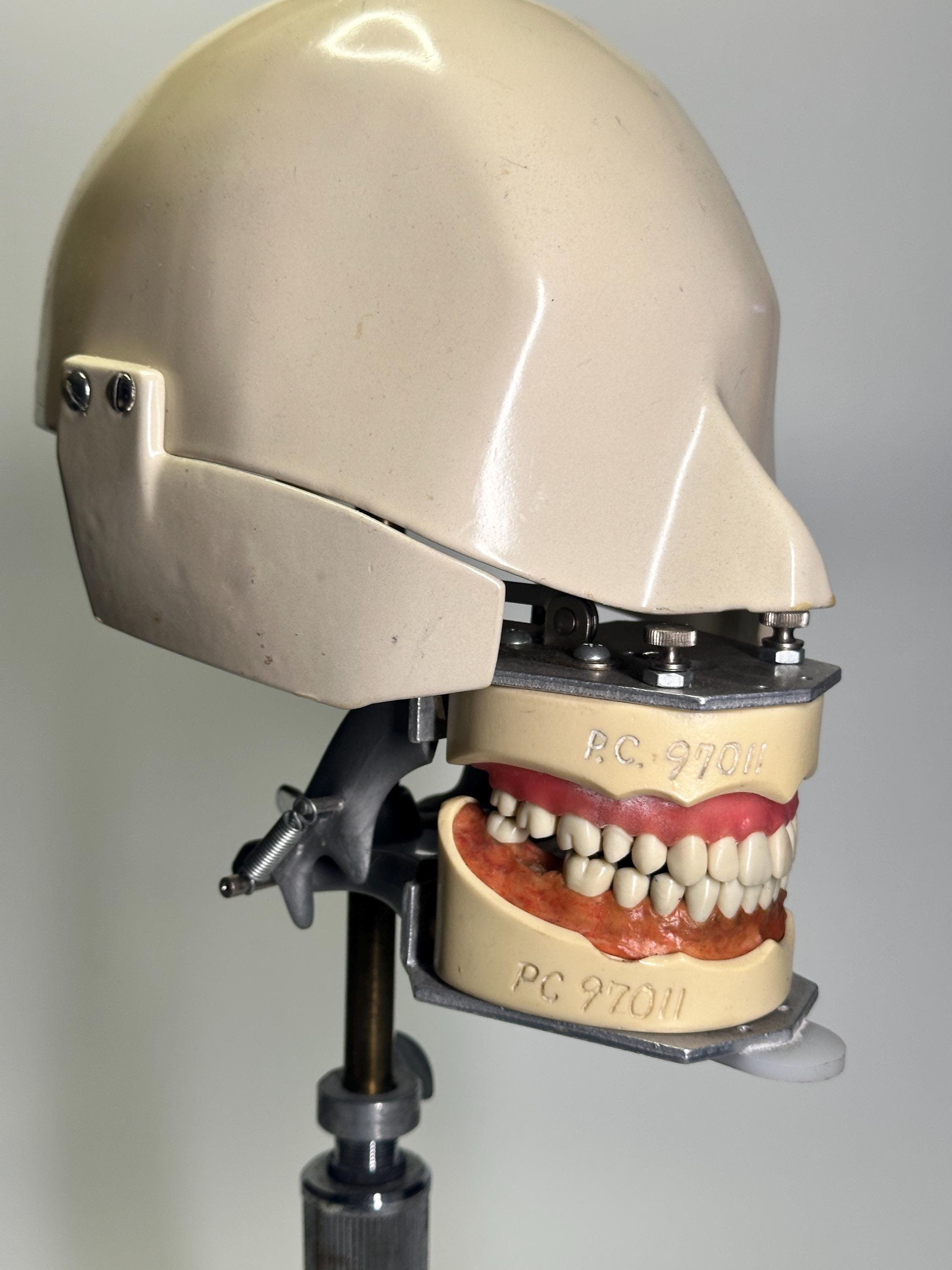 Image 5 of 10
Image 5 of 10

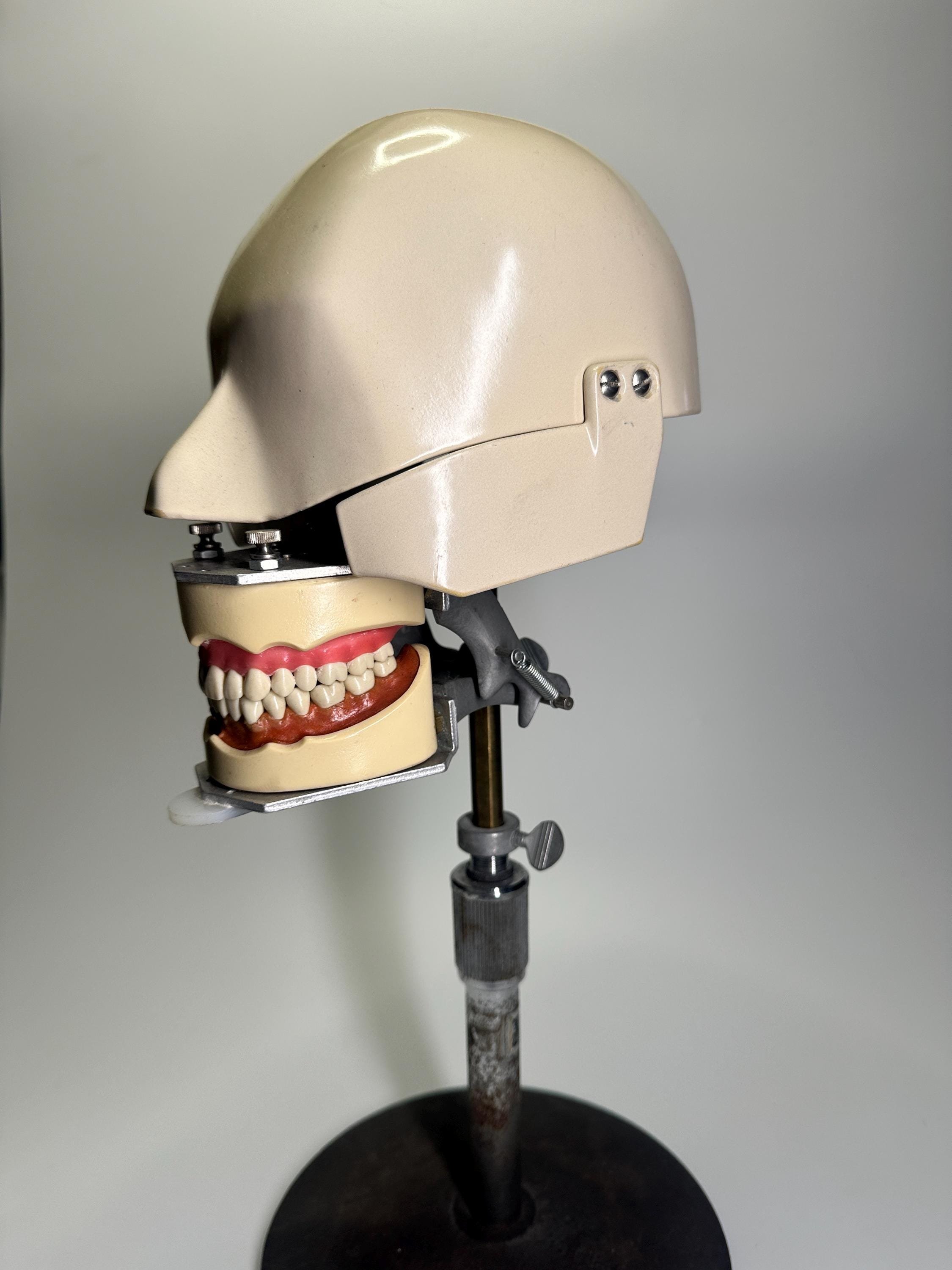 Image 6 of 10
Image 6 of 10

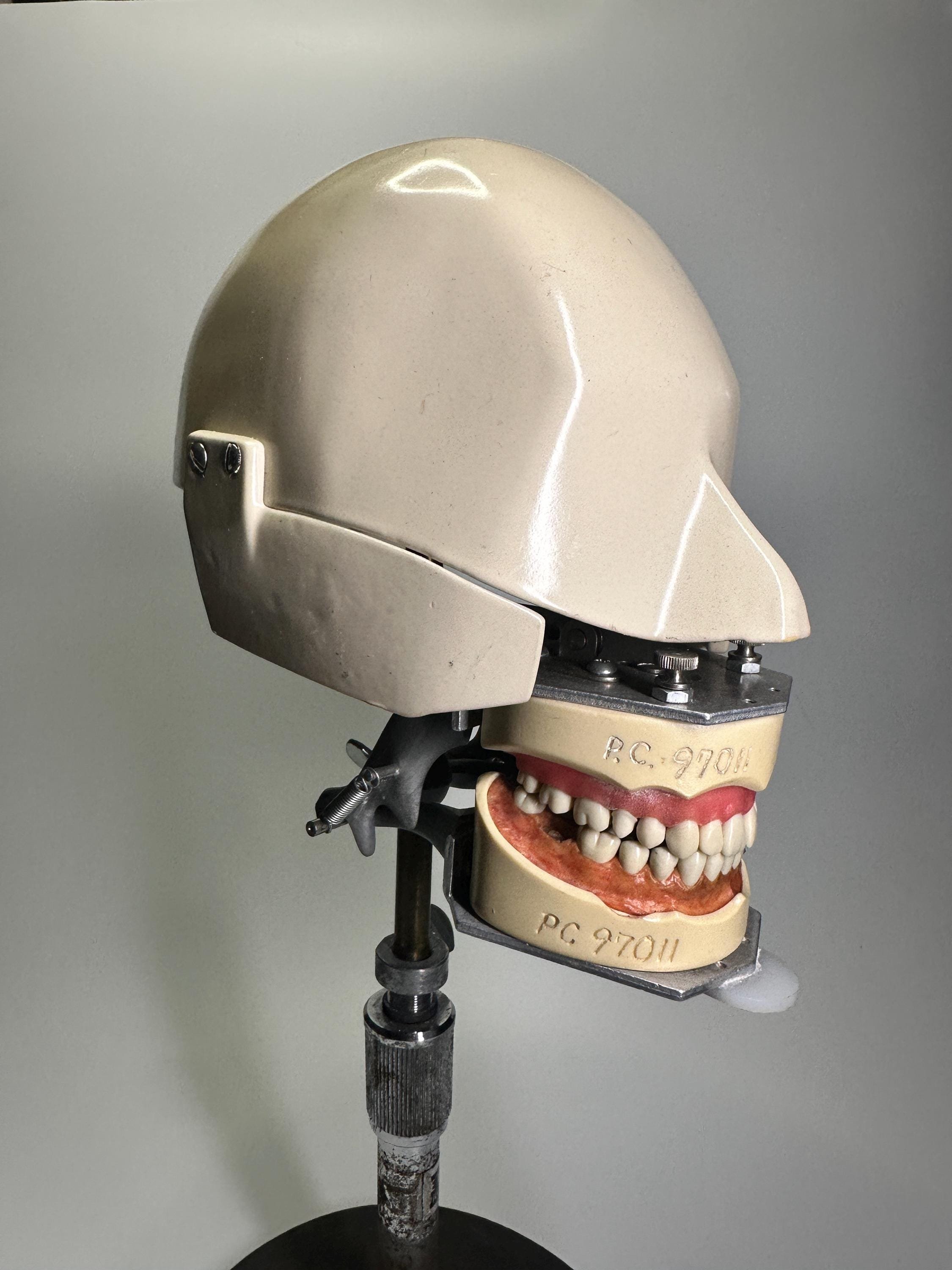 Image 7 of 10
Image 7 of 10

 Image 8 of 10
Image 8 of 10

 Image 9 of 10
Image 9 of 10

 Image 10 of 10
Image 10 of 10











Dental Phantom 1970s with Rubber Face Mask Oddity & Curiosity
$900.00
A 1970s dental phantom, often referred to as a dental manikin or typodont, was a training tool designed to simulate the human oral cavity for dental students and professionals. These phantoms were typically constructed with a metal or plastic framework supporting a lifelike head or jaw model.
Key Features:
1. Realistic Anatomy:
• The phantom included artificial teeth and gums made of durable materials like acrylic or resin. The teeth were often replaceable, allowing for practice of various procedures like cavity preparation or crown fitting.
• The jaw might have movable joints to simulate natural mouth opening and closing.
2. Rigid Structure:
• The phantom head was mounted on a stand or armature, which could be adjusted to mimic different patient positions during treatment.
3. Materials:
• Early models were primarily made from metal and rigid plastics, which made them durable but somewhat heavy compared to modern versions.
4. Simulation Tools:
• Some versions included soft-tissue simulators or water systems for practicing dental procedures under simulated conditions.
• Phantoms used in the 1970s often lacked the advanced realism of modern silicone-based materials but were still sufficient for tactile and visual learning.
5. Manual Operation:
• Unlike today’s phantoms with digital integration, 1970s models relied on manual adjustments and required the dental student to interpret results without technological feedback.
These phantoms were essential for preclinical training, helping students gain familiarity with dental instruments, techniques, and ergonomics in a controlled environment.
Key Features:
1. Realistic Anatomy:
• The phantom included artificial teeth and gums made of durable materials like acrylic or resin. The teeth were often replaceable, allowing for practice of various procedures like cavity preparation or crown fitting.
• The jaw might have movable joints to simulate natural mouth opening and closing.
2. Rigid Structure:
• The phantom head was mounted on a stand or armature, which could be adjusted to mimic different patient positions during treatment.
3. Materials:
• Early models were primarily made from metal and rigid plastics, which made them durable but somewhat heavy compared to modern versions.
4. Simulation Tools:
• Some versions included soft-tissue simulators or water systems for practicing dental procedures under simulated conditions.
• Phantoms used in the 1970s often lacked the advanced realism of modern silicone-based materials but were still sufficient for tactile and visual learning.
5. Manual Operation:
• Unlike today’s phantoms with digital integration, 1970s models relied on manual adjustments and required the dental student to interpret results without technological feedback.
These phantoms were essential for preclinical training, helping students gain familiarity with dental instruments, techniques, and ergonomics in a controlled environment.
Add To Cart
A 1970s dental phantom, often referred to as a dental manikin or typodont, was a training tool designed to simulate the human oral cavity for dental students and professionals. These phantoms were typically constructed with a metal or plastic framework supporting a lifelike head or jaw model.
Key Features:
1. Realistic Anatomy:
• The phantom included artificial teeth and gums made of durable materials like acrylic or resin. The teeth were often replaceable, allowing for practice of various procedures like cavity preparation or crown fitting.
• The jaw might have movable joints to simulate natural mouth opening and closing.
2. Rigid Structure:
• The phantom head was mounted on a stand or armature, which could be adjusted to mimic different patient positions during treatment.
3. Materials:
• Early models were primarily made from metal and rigid plastics, which made them durable but somewhat heavy compared to modern versions.
4. Simulation Tools:
• Some versions included soft-tissue simulators or water systems for practicing dental procedures under simulated conditions.
• Phantoms used in the 1970s often lacked the advanced realism of modern silicone-based materials but were still sufficient for tactile and visual learning.
5. Manual Operation:
• Unlike today’s phantoms with digital integration, 1970s models relied on manual adjustments and required the dental student to interpret results without technological feedback.
These phantoms were essential for preclinical training, helping students gain familiarity with dental instruments, techniques, and ergonomics in a controlled environment.
Key Features:
1. Realistic Anatomy:
• The phantom included artificial teeth and gums made of durable materials like acrylic or resin. The teeth were often replaceable, allowing for practice of various procedures like cavity preparation or crown fitting.
• The jaw might have movable joints to simulate natural mouth opening and closing.
2. Rigid Structure:
• The phantom head was mounted on a stand or armature, which could be adjusted to mimic different patient positions during treatment.
3. Materials:
• Early models were primarily made from metal and rigid plastics, which made them durable but somewhat heavy compared to modern versions.
4. Simulation Tools:
• Some versions included soft-tissue simulators or water systems for practicing dental procedures under simulated conditions.
• Phantoms used in the 1970s often lacked the advanced realism of modern silicone-based materials but were still sufficient for tactile and visual learning.
5. Manual Operation:
• Unlike today’s phantoms with digital integration, 1970s models relied on manual adjustments and required the dental student to interpret results without technological feedback.
These phantoms were essential for preclinical training, helping students gain familiarity with dental instruments, techniques, and ergonomics in a controlled environment.
A 1970s dental phantom, often referred to as a dental manikin or typodont, was a training tool designed to simulate the human oral cavity for dental students and professionals. These phantoms were typically constructed with a metal or plastic framework supporting a lifelike head or jaw model.
Key Features:
1. Realistic Anatomy:
• The phantom included artificial teeth and gums made of durable materials like acrylic or resin. The teeth were often replaceable, allowing for practice of various procedures like cavity preparation or crown fitting.
• The jaw might have movable joints to simulate natural mouth opening and closing.
2. Rigid Structure:
• The phantom head was mounted on a stand or armature, which could be adjusted to mimic different patient positions during treatment.
3. Materials:
• Early models were primarily made from metal and rigid plastics, which made them durable but somewhat heavy compared to modern versions.
4. Simulation Tools:
• Some versions included soft-tissue simulators or water systems for practicing dental procedures under simulated conditions.
• Phantoms used in the 1970s often lacked the advanced realism of modern silicone-based materials but were still sufficient for tactile and visual learning.
5. Manual Operation:
• Unlike today’s phantoms with digital integration, 1970s models relied on manual adjustments and required the dental student to interpret results without technological feedback.
These phantoms were essential for preclinical training, helping students gain familiarity with dental instruments, techniques, and ergonomics in a controlled environment.
Key Features:
1. Realistic Anatomy:
• The phantom included artificial teeth and gums made of durable materials like acrylic or resin. The teeth were often replaceable, allowing for practice of various procedures like cavity preparation or crown fitting.
• The jaw might have movable joints to simulate natural mouth opening and closing.
2. Rigid Structure:
• The phantom head was mounted on a stand or armature, which could be adjusted to mimic different patient positions during treatment.
3. Materials:
• Early models were primarily made from metal and rigid plastics, which made them durable but somewhat heavy compared to modern versions.
4. Simulation Tools:
• Some versions included soft-tissue simulators or water systems for practicing dental procedures under simulated conditions.
• Phantoms used in the 1970s often lacked the advanced realism of modern silicone-based materials but were still sufficient for tactile and visual learning.
5. Manual Operation:
• Unlike today’s phantoms with digital integration, 1970s models relied on manual adjustments and required the dental student to interpret results without technological feedback.
These phantoms were essential for preclinical training, helping students gain familiarity with dental instruments, techniques, and ergonomics in a controlled environment.
